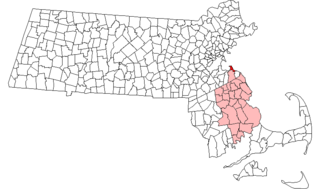
Hull is a town in Plymouth County, Massachusetts, United States, located on a peninsula at the southern edge of Boston Harbor. Its population was 10,293 at the 2010 census. Hull is the smallest town by land area in Plymouth County and the fourth smallest in the state. However, its population density is within the top thirty towns in the state.

Winthrop is a city in Suffolk County, Massachusetts, United States. The population was 17,497 at the 2010 census and as of 2019 the population has grown to an estimated 18,544. Winthrop is an ocean-side suburban community in Greater Boston situated at the north entrance to Boston Harbor, close to Logan International Airport. It is located on a peninsula, 1.6 square miles (4.2 km2) in area, connected to Revere by a narrow isthmus and to East Boston by a bridge over the harbor inlet to the Belle Isle Marsh Reservation. Settled in 1630, Winthrop is one of the oldest communities in the United States. It is also one of the smallest and most densely populated municipalities in Massachusetts. It is one of the four cities that comprise Suffolk County. It is the southernmost part of the North Shore, with a 7-mile (11 km) shoreline that provides views of the Atlantic Ocean to the east and of the Boston skyline to the west.

East Boston, nicknamed Eastie, is a neighborhood of Boston, Massachusetts with over 45,000 residents. Annexed by the city of Boston in 1836, it is bordered by the towns of Winthrop and Revere. It is separated from the Boston neighborhood of Charlestown and downtown Boston by Boston Harbor. The footprint of the East Boston neighborhood as it is known today was created in the 1940s by connecting five of the inner harbor islands using land fill.

The Boston Harbor Islands National Recreation Area is a national recreation area situated among the islands of Boston Harbor of Boston, Massachusetts. The area is made up of a collection of islands, together with a former island and a peninsula, many of which are open for public recreation and some of which are very small and best suited for wildlife. The area is run by the Boston Harbor Islands Partnership. It includes the Boston Harbor Islands State Park, managed by the Commonwealth of Massachusetts. Twenty-one of the 34 islands in the area are also included in the Boston Harbor Islands Archeological District.

Boston Harbor is a natural harbor and estuary of Massachusetts Bay, and is located adjacent to the city of Boston, Massachusetts. It is home to the Port of Boston, a major shipping facility in the northeastern United States.
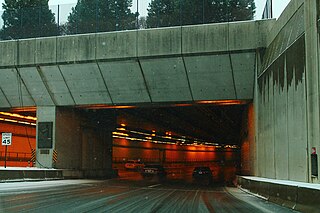
The Ted Williams Tunnel is a highway tunnel in Boston, Massachusetts; it is the third in the city to travel under Boston Harbor, with the Sumner Tunnel and the Callahan Tunnel. It carries the final segment of Interstate 90 from South Boston towards its eastern terminus at Route 1A in East Boston, slightly beyond Logan International Airport. The tunnel is named after the former Boston Red Sox baseball legend and U.S. Marine air corps veteran Ted Williams.

Apple Island was an island in Boston Harbor in Massachusetts, one of five islands that were integrated with landfill over the years to form East Boston and Logan International Airport. Noddle's Island, Hog Island, Bird's Island and Governor's Island were the others.

Wood Island station is a rapid transit and bus station on in Boston, Massachusetts. It serves the MBTA Blue Line and the MBTA bus system. It is located off Bennington Street in the Day Square section of East Boston. The station also serves as a bus transfer point for several local routes.
Samuel Maverick was a 17th-century English colonist to the Massachusetts Bay colony. Arriving ahead of the Winthrop Fleet, Maverick became one of the earliest settlers, one of the largest landowners and one of the first slave-owners in Massachusetts. He signed his name as "Mavericke".
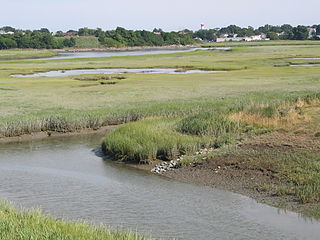
Belle Isle Marsh Reservation is an urban nature preserve and public recreation area containing mostly coastal wetlands. The Reservation includes the last remnant within Boston of the salt marshes that were once prevalent along the Massachusetts Bay shoreline. The marsh is home to a wide variety of saltmarsh plants, marine life, and birds. The reservation is managed by the Department of Conservation and Recreation.
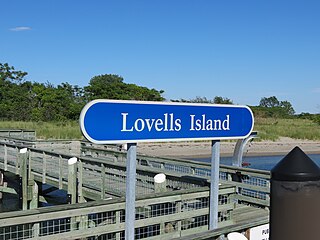
Lovells Island, or Lovell's Island, is a 62-acre (250,000 m2) island in the Boston Harbor Islands National Recreation Area, in Massachusetts. The island is across The Narrows from Georges Island and some 7 miles (11 km) offshore of downtown Boston. It is named after Captain William Lovell, who was an early settler of nearby Dorchester. The island is known as the site of several shipwrecks, including the 74-gun French warship Magnifique in 1782.

Rainsford Island, formerly known Hospital Island, Pest House Island, and Quarantine Island, is a 11-acre (45,000 m2) island in the Boston Harbor, situated between Long Island and Peddocks Island. The island is composed of two drumlins, reaching an elevation of 49 feet (15 m) above sea level. The shoreline is predominantly rocky with a sandy cove in the south side, and a variety of wildflowers abound. Access is by private boat only. Since 1996 it has been part of the Boston Harbor Islands National Recreation Area.

Deer Island is a peninsula in Boston, Massachusetts. Since 1996, it has been part of the Boston Harbor Islands National Recreation Area. Although still an island by name, Deer Island has been connected to the mainland since the former Shirley Gut channel, which once separated the island from the town of Winthrop, was filled in by the 1938 New England hurricane. Today, Deer Island is the location of the Deer Island Waste Water Treatment Plant, whose 150-foot-tall (46 m) egg-like sludge digesters are major harbor landmarks.

Governors Island was an island in Boston Harbor in the U.S. state of Massachusetts. The island was subsumed by land reclamation for the construction and extension of Logan International Airport.

Spinnaker Island is an island in the Hingham Bay area of Boston Harbor in Massachusetts, USA. The island is part of the town of Hull, to which it is connected by a bridge, and is one of the few harbor islands that neither forms part of the Boston Harbor Islands National Recreation Area nor is considered within the municipal limits of the city of Boston.

The Battle of Chelsea Creek was the second military engagement of the Boston campaign of the American Revolutionary War. It is also known as the Battle of Noddle's Island, Battle of Hog Island and the Battle of the Chelsea Estuary. This battle was fought on May 27 and 28, 1775, on Chelsea Creek and on salt marshes, mudflats, and islands of Boston Harbor, northeast of the Boston peninsula. Most of these areas have since been united with the mainland by land reclamation and are now part of East Boston, Chelsea, Winthrop, and Revere.

The New England Colonies of British America included Connecticut Colony, the Colony of Rhode Island and Providence Plantations, Massachusetts Bay Colony, Plymouth Colony, and the Province of New Hampshire, as well as a few smaller short-lived colonies. The New England colonies were part of the Thirteen Colonies and eventually became five of the six states in New England, with Plymouth Colony absorbed into Massachusetts and Maine separating from it. Captain John Smith's 1616 work A Description of New England first applied the term "New England" to the coastal lands from Long Island Sound to Newfoundland.

Moses King was an editor and publisher who produced guidebooks to travel destinations in the United States, including Massachusetts and New York.
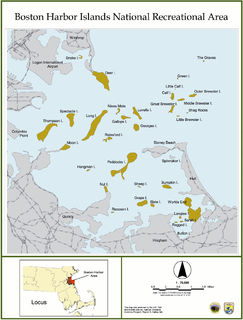
The Harbor Defenses of Boston was a United States Army Coast Artillery Corps harbor defense command. It coordinated the coast defenses of Boston, Massachusetts from 1895 to 1950, beginning with the Endicott program. These included both coast artillery forts and underwater minefields. The command originated circa 1895 as the Boston Artillery District, was renamed Coast Defenses of Boston in 1913, and again renamed Harbor Defenses of Boston in 1925.

Moses Forster Sweetser authored travel books on the White Mountains, Maine in 1880, Massachusetts (1889), and a handbook on the U.S. (1891). He also wrote several biographies on artists including Guido Reni, Raphael, Fra Angelico, Sir Joshua Reynolds, Leonardo Da Vinci, Bartolomé Esteban Murillo, Washington Allston, Landseer, Claude Lorraine, and Dürer. He was affiliated with the Moses King Corporation.



















